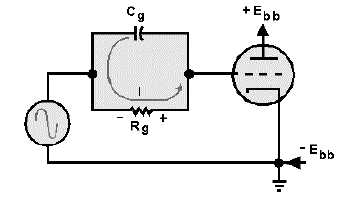1-36
Figure 1-26.—Series grid-leak biasing.
In summary, grid-leak bias causes the grid to draw current when the input signal goes positive. This
grid current (which is a negative charge) is stored by the coupling capacitor (Cc,) which will keep the grid
at some negative potential. It is this potential that biases the tube.
Q21.
What type of bias requires constant current flow through the cathode circuit of a triode?
Q22.
When a circuit uses cathode biasing, the input signal can cause variations in the biasing level
How is this problem eliminated?
Q23.
In a circuit using grid-leak biasing, the coupling capacitor (Cc) charges through a low
resistance path. What resistance is used in this charge path?
Q24.
Grid-leak biasing in effect rectifies the input ac signal. What feature of the circuit is used to
accomplish this rectification?
OPERATING CLASSIFICATIONS OF TUBE AMPLIFIERS
While the discussion of amplifiers will be covered in detail in later NEETS modules, some discussion
of the classes of operation of an amplifier is needed at this point. This is because their operation class is
directly determined by the bias voltage of the tube.
The classification of amplifiers by operation is based on the percentage of the time that the tube
conducts when an input signal is applied. Under this system amplifiers may be divided into four main
classes: A, AB, B, and C.
CLASS A OPERATION
An amplifier biased into Class A operation, is one in which conduction through the tube occurs
throughout the duration of the input signal. Such an amplifier is shown in figure 1-27, view A. This is the
same type of circuit with which you are already familiar. Notice when you compare the input to the
output that the tube is always conducting, and that the entire input signal is reproduced at the output.

